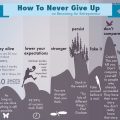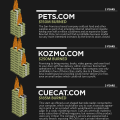5 Lessons Every Entrepreneur Can Learn from Successful Startups
5 Lessons Every Entrepreneur Can Learn from Successful Startups
As an entrepreneur, there’s no shortage of advice and guidance out there. But let’s face it – some of the most valuable lessons come from those who have been in your shoes before. Successful startups are like beacons of hope, shining examples of what can be achieved with dedication, perseverance, and a willingness to learn.
In this article, we’ll dive into five key lessons that every entrepreneur can learn from successful startups. From embracing failure to prioritizing customer needs, these takeaways will help you navigate the ups and downs of building your own business. So, let’s get started!
Lesson #1: Embracing Failure is a Crucial Part of Success
Airbnb is a household name today, but did you know that the company faced rejection after rejection in its early days? In fact, co-founder Brian Chesky has spoken publicly about how he and his team were rejected by seven investors before finally securing funding.
The lesson here is clear: failure is not the end of the world. In fact, it’s often a stepping stone to success. Every successful startup has experienced setbacks along the way – what sets them apart is their ability to bounce back, learn from those failures, and use that knowledge to improve their product or service.
As an entrepreneur, you’ll inevitably face rejections, mistakes, and disappointments. But instead of letting these failures define you, try to view them as opportunities for growth. Ask yourself: what can I learn from this experience? How can I apply these lessons to my business moving forward?
Lesson #2: Validate Your Idea Before Scaling
When Dropbox first launched in 2007, it wasn’t the sleek, user-friendly platform we know today. In fact, co-founder Drew Houston has admitted that the initial version of the product was “pretty rough.”
So why did Dropbox take off? The answer lies in validation. Before scaling, Houston and his team made sure to validate their idea with a simple landing page. They created a video showcasing the product’s core functionality and waited for feedback.
The response was overwhelming – 75,000 people signed up for the service within weeks of the video going live. This early traction gave Dropbox the momentum it needed to scale, and today the company boasts over 500 million users worldwide.
As an entrepreneur, don’t be afraid to test your idea with a minimal viable product (MVP). Use this opportunity to validate demand, gather feedback, and refine your offering before investing too much time or resources. It’s better to iterate now than to scale a flawed concept later on.
Lesson #3: Focus on Solving Real Problems
When Warby Parker co-founders Neil Blumenthal and Dave Gilboa set out to disrupt the eyewear industry, they knew they had their work cut out for them. The market was dominated by established players with deep pockets – so how could two young entrepreneurs compete?
Their secret? Focusing on solving real problems. Warby Parker identified a pain point in the traditional eyewear experience: expensive glasses that were both poorly designed and inaccessible to many consumers.
By offering stylish, affordable frames online, Warby Parker tapped into this demand and quickly gained traction. Today, the company is worth over $1 billion – but it’s not just about the numbers; Warby Parker has genuinely improved people’s lives by making eyewear more accessible.
As an entrepreneur, ask yourself: what real problems am I solving? Am I creating a solution that will truly improve my customers’ lives, or am I simply trying to make a quick buck? Remember, successful startups prioritize value creation over profit – at least in the early days.
Lesson #4: Prioritize Customer Needs Over Everything Else
When Amazon first launched in 1995, it wasn’t the behemoth we know today. In fact, Jeff Bezos started out by selling books from his garage!
But what drove Amazon’s meteoric rise to success? One word: customer obsession. Bezos has famously stated that “customer satisfaction is a seductive mistress” – and he’s right.
From offering free shipping to introducing Alexa, Amazon has consistently prioritized customer needs above all else. This commitment to delivering value has earned the company an almost cult-like following – and today it’s one of the world’s most valuable companies.
As an entrepreneur, don’t lose sight of who matters most: your customers. Prioritize their needs, listen to their feedback, and iterate on your product or service to meet those demands. It’s not about being perfect; it’s about continually improving and showing your customers that you care.
Lesson #5: Stay Lean and Agile in a Rapidly Changing Market
Instagram is another startup success story that began with humble beginnings. When Kevin Systrom launched the app in 2010, it was just a simple photo-sharing platform.
But here’s what set Instagram apart from other startups at the time: its willingness to stay lean and agile. As user behavior shifted towards mobile-first experiences, Instagram adapted quickly – introducing new features like Stories and Reels to keep pace with changing consumer demands.
Today, Instagram boasts over 1 billion active users – a testament to the power of staying nimble in a rapidly changing market. By prioritizing agility, you can respond quickly to emerging trends, iterate on your product or service, and stay ahead of the competition.
As an entrepreneur, remember that your business plan is not set in stone. Stay open to new ideas, be willing to pivot when necessary, and prioritize speed over perfection. In today’s fast-paced startup landscape, adaptability is key to survival – let alone success!
Conclusion
There you have it – five lessons from successful startups that every entrepreneur can learn from. From embracing failure to prioritizing customer needs, these takeaways offer a roadmap for navigating the ups and downs of building your own business.
Remember, starting a business is hard – but with perseverance, dedication, and a willingness to learn, you too can join the ranks of these startup success stories. So don’t be afraid to get started today – the world is waiting for what you have to offer!
Additional Resources
For more insights on entrepreneurship and startups, check out these recommended resources:
- “The Lean Startup” by Eric Ries
- “Startup Nation” by Dan Senor and Saul Singer
- “How to Win Friends and Influence People” by Dale Carnegie
By applying the lessons outlined in this article – and continually learning from other successful entrepreneurs – you’ll be well on your way to building a business that truly changes lives.








